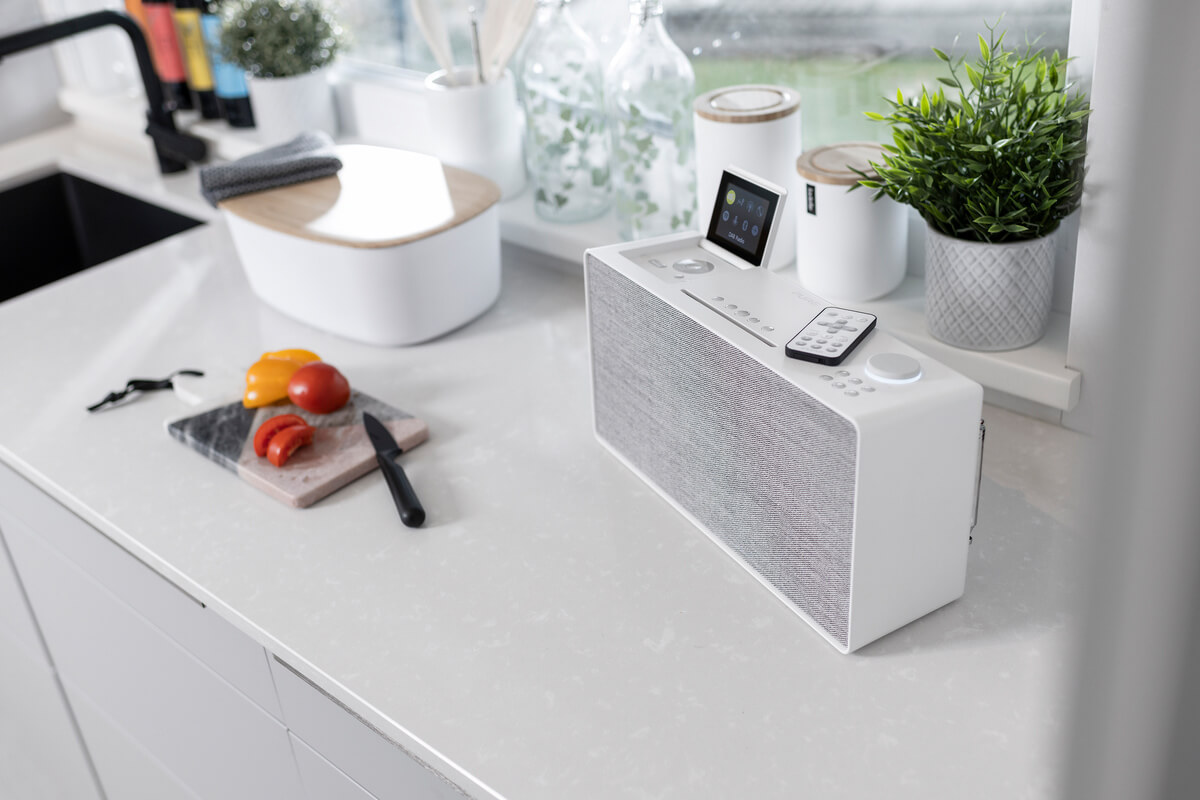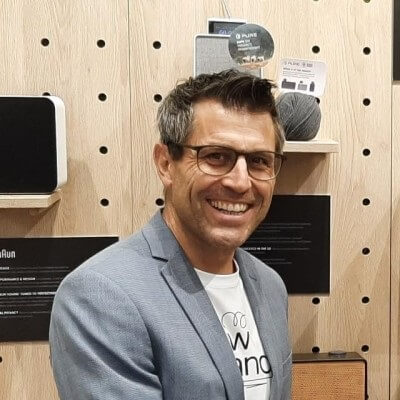Everything you need to know about DAB or DAB+ radio (Digital Audio Broadcasting)
The practice of streaming may be on the rise thanks to providers such as Spotify or Amazon, however, radio is still the most popular mass medium. According to statistics, an average person listens to the radio approximately three hours per day, preferably at the highest sound quality possible.
And this is where DAB radio, respectively DAB+ radio (dab/dab+) comes in: This type of digital radio plays any content without static noise and provides quality on par with that of CDs. What’s more, it is able to receive far more stations than your good old FM radio – even in remote areas. You can listen to BBC 6 in the UK, but also to Radio Energy out of Germany.
In this article, we’ll take a look at how that’s possible and explain the differences between digital radio, internet radio and FM radio, while also providing insights into why DAB makes sense and which devices are DAB or DAB+ enabled.
What exactly is DAB radio?
DAB is short for Digital Audio Broadcasting, meaning the digital transmission of sound. DAB radios are digital radios that are the successors of classic FM radios. While they don’t look any different from the outside, it is their interior that sets them apart. As opposed to digital radios, FM radios receive their sound via radio waves, also known as USW or Ultra Short Waves, which cannot be transmitted over large distances.
In addition, this form of transmission requires the frequency to be re-tuned as soon as there is a change of location, which is unnecessary with digital audio broadcasting. But there’s more: DAB has further benefits, including the ability to receive content at high quality – and without any annoying static sound – in even the remotest area.
What’s the difference between DAB and FM radio?
As already mentioned, the biggest difference is in the mode of transmission. While FM radios are analogue, using radio waves, DAB radios receive content digitally. Thanks to DAB radio, which is digital-terrestrial, radio programmes can be received without the static noise caused by radio waves.
Furthermore, digital radios no longer require tuning – or in other words, the manual selection of stations, and preferred stations don’t have to be saved in the station memory, as digital radios come with an automatic channel search function. It is thus just a question of time before DAB radio will replace FM radio altogether – simply based on the fact that it is better than retro FM radio.
Its superiority also shows on another level: While FM only allows for one station per frequency, digital radio enables the consolidation of several radio programmes in a single channel. However, that being said, DAB is not necessarily worth it for small regional stations that only serve limited areas that are mostly not covered by DAB.
What’s the difference between DAB and internet radio?
While DAB radios receive content digitally, internet radios stream programmes online. In order to do so, internet radios require a reliable, stable internet connection. An extensive choice is one of their main advantages, with more than 70,000 stations from around the world, including Spotify Radio, being available online. In addition to your favourite radio programme you can also find podcasts and tailor-made playlists.
And as if that wasn’t enough, an internet radio always comes with DAB- and FM-ability. This means you can listen to radio not only online, but offline too, albeit with a limited range and choice.
When was digital radio first introduced?
In 1986, the European Ministerial Conference passed a resolution to establish a common digital radio broadcasting system, which can be seen as the trigger for the development of Digital Audio Broadcasting. Germany took a leading role in the so-called Eureka-147 project with the aim to establish DAB as a new EU standard. It is suited for a frequency spectrum ranging from 30 megahertz to three gigahertz, a range that is also able to receive radio programmes via cables or satellite.
The idea behind DAB: In order to achieve nationwide or trans-regional coverage, radio stations within the FM network can only reuse the same frequency at certain, larger geographical intervals. And because FM only uses a frequency spectrum ranging from 87.5 to 108 Megahertz it was difficult in the past to offer more than a handful of nationwide stations. Those were complemented by local stations that offered regionally relevant programmes with the problem being that there were hardly any free frequencies left for private stations.
The gradual implementation of DAB commenced in 1995 in Germany and the UK, the latter of which now boasts one of the most extensive digital radio networks. That being said, these days DAB is available extensively in most European countries, including Germany.
What are the advantages of DAB radio?
If you receive your radio programme via digital radio, you will feel like listening to a CD: As long as you are within the transmission range, you can listen to your favourite station without being interrupted by static noise, which is one of the main benefits of DAB radio. If you are outside the transmission range, you won’t receive anything at all – no music, no sound, but also no static noise.
Since Digital Audio Broadcasting covers a much more extended frequency range than FM, it offers a bigger variety of stations. This variety is amplified even further thanks to the fact that each frequency in the digital realm can be assigned more than once, resulting in one channel being able to offer several radio programmes.
Internet radio obviously offers an even larger choice, however: Digital radio is the safest bet in sparsely populated areas with unreliable internet reception. Apart from that, DAB radio is a better choice for listening to radio while driving, as it is usually more reliable outside metropolitan areas. Also, in order to receive internet radio, you require data, and if you don’t have a flat rate, this can lead to exorbitant costs pretty quickly, while DAB works offline and thus won’t lead to any unexpected additional costs.
DAB and DAB+ what’s the added value of DAB+ radio?
DAB is the predecessor of DAB+ and by now it is integrated as a standard technology for car radios in vehicles destined for the European market. In fact, an increasing number of radio programmes is only available via DAB+ and consequently there is a growing range of DAB+ digital radios. You have the choice between compact portable devices such as the Pure Elan and comprehensive all-in-one music systems such as the intuitive Evoke Home, both of them developed and designed by Pure.
And here are the most important differences between DAB and DAB+ at a glance:
- A DAB+ radio uses an MPEG-4 audio-codec, which is considered to be one of the best codes, while DAB radios use the inferior MPEG-1 codec to compress files.
- While DAB has a data transmission rate of 128 kB per second, DAB+ works with 80 kB per second, which is markedly lower. However, thanks to this lower data rate a single channel can accommodate a multitude of stations. Apart from superior terminal devices this requires the more powerful MPEG-4 audio codec for data compression.
Recommendations for DAB+ radio reception
DAB+ digital radio may come with unsurpassed sound quality, however, the quality of reception, which depends on the broadcasting area, may fluctuate. If necessary, the following recommendations will help improve reception:
Mobile DAB+ radios: Improving the signal by repositioning the DAB+ radio
With portable radios, reception strongly depends on position, which means that the digital radio should ideally be placed by the window or on an outside wall. The reception signal can be amplified by using an antenna. Many radios have the option to add an extra outdoor antenna.
DAB+ car radio: Attach antenna following guidebook
If you are looking to buy a used car that doesn’t have DAB+ as a standard, you can easily upgrade the existing radio. The most important thing is the correct alignment of your antenna. Our advice is to follow the manufacturer’s instructions. The attachment usually depends on the model; it will either be fixed to the rubber seal or on the outside of the vehicle. However, be aware that there can still be outages and malfunctions, as not all stations come with blanket coverage. Furthermore, geographical obstacles and weather (mountains, tunnels or rain) can impact reception.
DAB+ car radios
It was only a matter of time for DAB plus to capture the market. As of 2021, all new cars destined for the European Union are required to have digital radios. As stipulated by law, all radio devices supporting RDS (which allows to display some basic information such as station name) need to be able to do the same with DAB+ (which will allow for a whole range of additional information).
The consequence: Radios with FM reception are hardly available these days. Obviously, this has its benefits too, as digital radio offers additional services, perfect sound quality and a myriad of programmes.
DAB+ reception and sound quality
Consumers changing to DAB+ digital radio will get a number of benefits:
- The sound quality of digital radios is considerably better than that of FM radios. There is no more noise interference (you are either within or outside the broadcasting area), the transmitted frequency band is broader and the loud- and undertones are better levelled.
- Thanks to an increased frequency range and the option to have several programmes on a single channel there is a much wider choice of stations.
- Since there is no need for streaming, as is the case with internet radio, there are no additional costs.
- DAB+ is neither a broadcasting nor a streaming service. On the contrary, Digital Audio Broadcasting offers an infinite number of radio programmes to choose from.
- DAB+ digital radios have the added benefit of being equipped with a number of additional services. For instance, they are able to display information like song title, artist and album cover. Slideshows and videos can also be transmitted via signal.
DAB+ additional services
With DAB+, additional multimedia services can be displayed in colour. This includes information regarding song title, artist and radio programme but also current news. Such services are generally also possible with FM radios, albeit to a lesser extent. RDS offers limited additional information such as the name of the radio station while DAB+ digital radio has these additional services at its core.
With “Dynamic Label plus”, a radio’s LCD display can show a variety of information, from the soccer table to the weather report. TPEG is another interesting service; it uses DAB+ to send current traffic information directly to the GPS.
What types of DAB radios are there?
Currently, digital radios come with a dab+/FM standard, meaning they can receive both analogue and digital content. Another option is to go for an internet radio that is DAB+ and FM-enabled.
You have the choice of the following DAB+ radios:
- A portable, battery-powered DAB radio like the Pure Evoke Play
- Compact DAB radios for around the home like the Pure Elan DAB+
- DAB radio alarms like the Siesta Rise by Pure. They are ideal for anyone wanting to start the day with their favorite radio station (with sleep timer and alarm function)
- Bluetooth DAB radios that can be paired with external devices like a smartphone. If used for streaming, the Siesta S 6 by Pure is turned into a wireless Bluetooth loudspeaker
- DAB+ radios used as kitchen radios
- Hi-Fi systems with DAB like the Pure Evoke Home, where DAB is a practical add-on
- DAB+ radios with CD player
- Car radios with DAB functionality – the current European standard
A choice of DAB+ programmes
We have compiled a list of the top 3 DAB+ stations in Germany, the UK and the EU that you can use as a guide through the growing jungle of DAB audio programmes.
Germany
1. Deutschlandfunk
A popular public service broadcaster with a focus on information and background stories in addition to culture. While during the day the programme focuses on current topics, culture features prominently in the evening programme.
2. Radio Energy
According to the motto “Hit Music Only” the station really plays hits only, and the programme is rarely interrupted by presenters.
3. Byte FM
A radio programme featuring interviews and background info that can also be streamed online. Byte FM was awarded the Grimme Online Award for its concept.
Great Britain
1. Capital Dance
The station is specialised in Dance, from House to Trance, and is also available on Spotify.
2. Absolute Radio
According to the motto “Real Music Matters” the station with its headquarters in London serves the UK with rock music.
3. BBC 6
BBC 6 is also based in London but focuses on newcomers and independent artists. People who prefer mainstream are better off with BBC 1.
EU
1. BFM Business
BFM Business is a French station that is all about economic and financial topics, with recommendations and on-topic interviews with CEOs, politicians and experts.
2. Radio Kiss Kiss
Radio Kiss Kiss broadcasts from Naples and is one of the most popular Italian stations. It mostly plays Soul and Funk from a range of different artists. According to the motto “Play everywhere” the programme is available all over Italy.
3. Radio Swiss Jazz
A Swiss station that plays Jazz Standards, Swing, Bebop, Soul and Blues – all day long and without being interrupted by commercial breaks or presenters.
FAQ’s DAB and DAB+ Radio:
What does DAB mean in connection with radios?
DAB is short for Digital Audio Broadcasting, which means that sound is being received digitally rather than via radio waves, as is the case with retro FM radios.
How can I receive DAB radio?
You need a DAB-enabled radio. For car radios, DAB+ has been introduced as a standard in 2021.
What are the advantages of a DAB radio?
As long as you are in the broadcasting area, the sound quality is crystal clear and free of any static noise. You can choose from many more stations and profit from automatic station search. Furthermore, DAB radio is more energy efficient than internet radio or FM radio.
Are DAB radios the same as internet radios?
No. DAB radios are digital radios that work offline, receiving content via a broadcasting tower. Internet radios stream data from the web, which is why they require a stable, reliable internet connection. All internet radios are DAB-enabled.
What’s the difference between DAB and DAB+ radios?
DAB+ radio is the successor of DAB. It comes with an increased performance since it is able to accommodate more stations on a single frequency. This requires a higher degree of compression with high-quality codes along with more powerful terminal devices.
What’s better, FM or DAB radios?
DAB radio is better as it provides sound of the same quality as a CD, free of static noise. In addition, it comes with an automatic station search function (instead of the need for manual tuning) and offers a multitude of radio programs.






